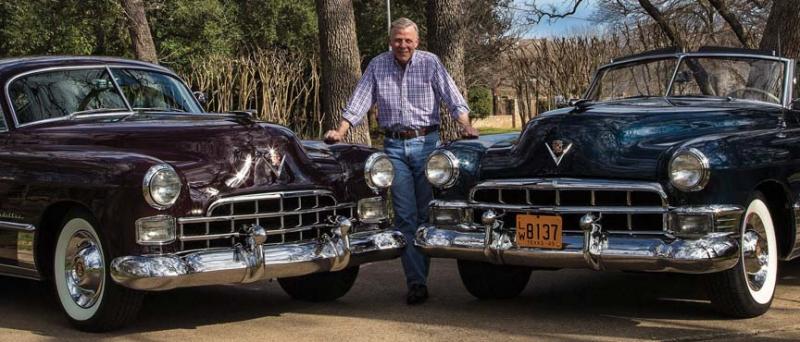
This month, Arlington Today revisits
Arlington classic car collector Mike Ames. So why, you may ask, does he have two Cadillacs that are so similar? That’s a good question, but we have some really good answers.
When General Motors resumed building automobiles after World War II, the lineup across all its models looked pretty much like it did when the automobile company ceased production at the beginning of the war.
During the war years,
the car plants were making war machinery, including tanks. Cadillac built the M24 Chaffee that was powered by two of its V-8 engines.
One of those engines was installed in General George S. Patton’s staff car, a 1938 Cadillac Limousine.
The Cadillac division made a bold decision to introduce a significant renovation when the 1948 models began to roll off the assembly lines.
The Madeira Maroon coupe on the left above is one of those. It’s equipped with the same basic big block engine model as the one in the tanks and Patton’s car and the last time it would be used in Cadillacs.
In 1949 the company introduced the first small block overhead V8 – the forerunner to all modern V8 engines. The Antoinette Blue convertible on the right is one of those. However, the power plant is only one of the things that separated the two model years and set up transformations that would continue throughout the decade of the 1950s and beyond.
So we begin to see why Mike would want both examples of a significant turning point in the emergence of General Motors as the world’s largest corporation. With these models, Cadillac would overtake competitor Packard Motor Company and bring the end of the “last true Packard” in 1956.
Without a doubt,
the most controversial design feature in these cars was the introduction of the rear fins that Mike is holding onto in our feature photo.
The fins are modeled after the Lockheed P-38 Lightning fighter aircraft; Cadillac took a chance by including a suggestion of the distinctive twin booms of the famous war plane that the Japanese named the “fork-tailed devil.”
The design risk paid off as it launched the era of rear fins that would grow longer and higher on just about all the American-made cars throughout the following decade and into the 1960s.
Another obvious change between the two model years is the reconfiguration of the back end in 1949, giving the vehicle a higher and bolder look for GM’s flagship luxury model. The hood line was stretched, and the goddess ornament moved forward to provide an even longer, sleeker look.
But doing so gave Mike the reason for declaring the ’48 Fastback his favorite of the two.
“I just love the sweep of the back of that car, along with the three-division rear window, the art deco chrome and all the history and style it represents,” he says.
Others might agree with Motor Trend Magazine’s decision to name its very first “Car of the Year” the 1949 model, sealing Cadillac’s position as the premiere American luxury brand for many years to come.

Then we find two completely different interiors when we look inside. The ’48 version is the only time the speedometer was presented in the style of a rainbow with the art deco touches complementing those on the exterior, while the ’49 features one of the all-time great dashboards, highlighted by tons of chrome.
Mike’s meticulous devotion
to detail and perfection of restoration to original specifications is demonstrated in both of these superb examples of automotive evolution.
The ’48 coupe originally sold for $2,900, while the ’49 convertible would have set you back $3,400. Although Mike is far more a collector than a seller, today’s auctions produce up to six figure-selling prices for the best ones, like these.
















